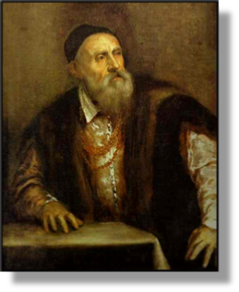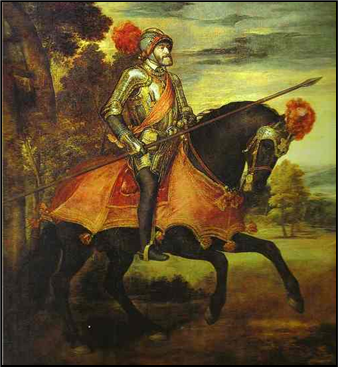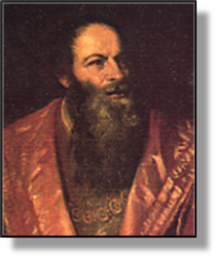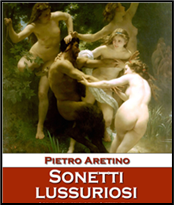


xxxxxAs we have seen (1523 H8), the Italian artist Titian was the greatest painter of the Venetian school, noted for his portraits as well as for his vast number of religious and mythological works. In style, he owed much to Giorgione, especially in the harmony of his composition and the depth and richness of his colours. To this period belongs his famous equestrian portrait of Charles V -
TITIAN c1487 -
Acknowledgements
Titian: Self-
 xxxxxAs we have seen (1523 H8), the Italian artist Titian (born Tiziano Vecellio) was one of the most outstanding and influential painters of the High Renaissance, and the greatest of the Venetian school. He gained particular fame for his vast number of religious and mythological works, but he was also a talented portrait painter, and served in the courts of both the Holy Roman Emperor, Charles V, and his son Philip II of Spain. As a result, his services were in constant demand, be it for portraiture, biblical themes, or "poetical compositions", as he called his mythological scenes.
xxxxxAs we have seen (1523 H8), the Italian artist Titian (born Tiziano Vecellio) was one of the most outstanding and influential painters of the High Renaissance, and the greatest of the Venetian school. He gained particular fame for his vast number of religious and mythological works, but he was also a talented portrait painter, and served in the courts of both the Holy Roman Emperor, Charles V, and his son Philip II of Spain. As a result, his services were in constant demand, be it for portraiture, biblical themes, or "poetical compositions", as he called his mythological scenes.
xxxxxHe was greatly influenced by Giorgione and it was to him he owed his early idyllic style and, perhaps more importantly, his brush technique, a skill which he developed further over his long career and which gave his work that  distinctive depth and richness of colour. And to this sumptuous colouring he added a harmony of composition and an atmospheric use of light, all of which made him the most famous artist of his day. Included in his early works, produced mainly in Venice, are those with a religious theme, such as Salome, Sacred and Profane Love, Christ before Pilate, and the monumental and magnificent The Assumption of the Virgin. Others are based on myth and legend like Bacchanal of the Andrians, the Worship of Venus and Bacchus and Ariadne, wherein sensuous female nudes show the influence of his master, Giovanni Bellini. His early portraits included those of the Emperor and of a number of local aristocrats, all eager to be portrayed by so distinguished an artist. Also belonging to this period were two keenly observed family groups, the Vendramin Family and Pope Paul III and his Grandsons.
distinctive depth and richness of colour. And to this sumptuous colouring he added a harmony of composition and an atmospheric use of light, all of which made him the most famous artist of his day. Included in his early works, produced mainly in Venice, are those with a religious theme, such as Salome, Sacred and Profane Love, Christ before Pilate, and the monumental and magnificent The Assumption of the Virgin. Others are based on myth and legend like Bacchanal of the Andrians, the Worship of Venus and Bacchus and Ariadne, wherein sensuous female nudes show the influence of his master, Giovanni Bellini. His early portraits included those of the Emperor and of a number of local aristocrats, all eager to be portrayed by so distinguished an artist. Also belonging to this period were two keenly observed family groups, the Vendramin Family and Pope Paul III and his Grandsons.
xxxxxIn 1548, he was invited to Augsburg by Charles V where he executed his now famous portrait of the Emperor on horseback (illustrated above). Here, like his portraits of many notables at this time, his aim was not to provide an insight into the man himself, but to emphasise the power, dignity and authority of the great office he held. The painting is remarkable for the mastery of its execution -
xxxxxOn returning to Venice in about 1550 -
Including:
Pietro
Aretino

 xxxxxAmong Titian's close friends was the poet and playwright Pietro Aretino (1492-
xxxxxAmong Titian's close friends was the poet and playwright Pietro Aretino (1492-
 xxxxxHe was born at Arezzo (hence his adopted name), and settled in Rome in 1517. In 1525, however, following the publication of his Lewd Sonnets (Sonetti Lussuriosi), complete with explicit engravings, he was obliged to leave the Holy City. He later got his own back in two works, Ragionamenti and Dialoghi, in which he took delight in revealing the vice and corruption within Rome, and the moral failings of some of the city's leading figures! He wrote five comedies about lower-
xxxxxHe was born at Arezzo (hence his adopted name), and settled in Rome in 1517. In 1525, however, following the publication of his Lewd Sonnets (Sonetti Lussuriosi), complete with explicit engravings, he was obliged to leave the Holy City. He later got his own back in two works, Ragionamenti and Dialoghi, in which he took delight in revealing the vice and corruption within Rome, and the moral failings of some of the city's leading figures! He wrote five comedies about lower-
xxxxxThe poet and playwright Pietro Aretino (1492-
M1-
xxxxxA highly successful and wealthy artist, Titian died in 1576, together with his son and assistant Orazio, both victims of the plague which was then raging through Venice. He was buried in the city's famous church of Saint Maria de Frari, where his huge and magnificent altarpiece, the Assumption of the Virgin, adequately testified to his greatness as a painter and his contribution to the field of visual art. His long and prolific career, rich as it was in artistic achievement and encompassing all aspects of the painter's art, had a profound effect upon El Greco, and many artists yet to come, including Rubens, Velasquez, Poussin, Rembrandt and Delacroix.



